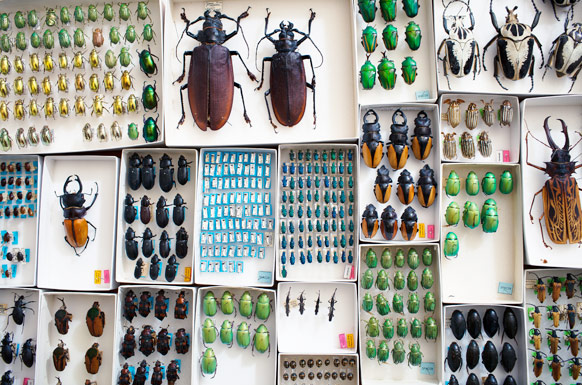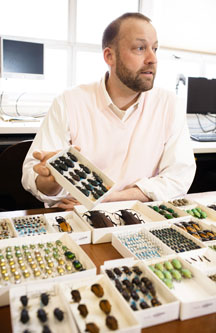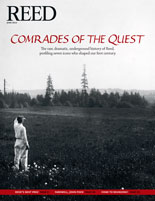
IRIS login | Reed College home Volume 91, No. 2: June 2012
Beetle Mania

Entomologist Christopher Marshall ’89 leads an army of 3 million at the Oregon State Arthropod Collection.
By Romel Hernandez
Photos by Matt D'Annunzio

“This, you’ve got to see,” says Chris Marshall ’89, carefully sliding a wooden drawer out of his cabinet of curiosities.
Inside, protected by a sheet of glass, a dozen beetles, each the size of a thumbnail, lie impaled on pins. These are no ordinary backyard creepy crawlies. They shimmer with an extraordinary metallic iridescence, looking more like pieces of jewelry carved of gold and silver than winged insects that flutter through the cloud forests of Central America feasting on foliage.

“They’re like precious gems.”
—Chris Marshall ’89
Although Chris has examined them many times, the sheer beauty of these two species of scarab beetles—Chrysina resplendens and C. optima, to be exact—still takes his breath away. “They’re like precious gems,” he says.
Being the curator of the Oregon State Arthropod Collection is the perfect job for Chris. Housed on the Oregon State University campus in Corvallis, the collection boasts almost 3 million specimens representing tens of thousands of species, making it the largest and most important in the Pacific Northwest. About 70% of the species come from the western United States; the rest hail from every continent except Antarctica.
Monstrous Titanus giganteus beetles whose pincer-like mandibles can snap a pencil in half. Agrias butterflies with their showy, psychedelic wings resembling tie-dye shirts. Dendroctonus ponderosae, weevils not much bigger than a grain of rice that, when assembled in their armies of millions, can chomp down a forest. Chris now has them all—or at least a good many of them. He happily calls studying insects a “compulsion,” adding, “I can’t walk past a stone without flipping it over to see what’s underneath.”
Every insect tells a unique story—about evolution, ecology, and even history (think the Black Plague). Insects give us insights into everything from genetics to global warming. An Illinois scientist, for example, is studying bumblebees from the OSU collection dating back decades to investigate the sudden decline of the species in the western U.S. (a pathogen is suspected).
“Ultimately, our mission is to preserve biodiversity for biologists, as well as for future researchers,” he says. “We’re not just dusting off shelves—maintaining our ties to research is vital.”
OSU entomologist David Maddison, director of the collection, says Chris brings a unique skill set to the job.
“Chris is top notch,” Maddison says. “He’s got a really strong vision for what the collection needs to be today, but he’s also thinking about 50 years from today.”
![]()
Chris can’t recall a time when he wasn’t fascinated by bugs.
Growing up in Lexington, Massachusetts, he collected bugs he found in his backyard. By the time he saw a 4-H insect collection at a state fair at the age of seven or eight, he was hooked—bitten by the bug, as it were. His father built him a wooden display case, and within a few years he was already specializing in beetles. He pored over books about insects, memorized the nomenclature of species, and even got a pet tarantula to overcome his aversion to spiders (which are arachnids, not insects).
At Reed, he flirted with herpetology, doing his senior thesis on fire-bellied toads. But professor Robert Kaplan [biology 1983–] suspected that he was always an entomologist at heart. Kaplan recalls a research expedition with students to study frogs in Korea in the mid-’80s. Sitting in a tent in the jungle going over notes with the students, he noticed Chris snatching at things in the air and stuffing them in his pockets. “He was collecting beetles,” Kaplan says. “He was very nonchalant about it—I was impressed.”
Although there was no entomologist on the faculty, Chris says, Reed was “where I got an exposure to true academia—an environment that rewarded thinking out of the box and finding creative approaches to solving problems . . . . Which is something I do here.”
After graduating, he headed to the East Coast, rekindling his interest in insects when he got a job working with the beetle collection at Harvard’s Museum of Comparative Zoology—a job he landed after visiting the museum to get help identifying some of the bugs he had collected in Korea. He went on to earn his PhD in entomology at Cornell, followed by fellowships at the Smithsonian and the Field Museum in Chicago, until he took the job at Oregon State in 2006.
Oregon State’s collection was started around the 1860s and maintains exceptional holdings in Coleoptera (beetles), Lepidoptera (butterflies and moths), Hymn-optera (bees and wasps), and Hemiptera (“true bugs,” including aphids, cicadas, and many other species). Chris spends most of his time on curatorial work—including the enormous task of digitizing and cataloging the extensive collection so that researchers anywhere in the world will soon be able to pull out a “virtual drawer” and examine images of any specimen in the collection.
He also pursues his own research. He has been involved in expeditions to jungles of South and Central America and has even hunted an uncommon type of fairy shrimp in the Reed canyon that had previously been known from just a handful of specimens in a museum. More recently, his work has centered on high-elevation insects in the Pacific Northwest. He has been strapping on snowshoes and a headlamp to tramp around the Cascades with Oregon State colleague Dave Lytle, looking at species inhabiting what is for most insects an unusual environment—the high, cold, and wet conditions of alpine snowfields at night. In fact, Chris believes they have encountered individuals that do not conform to species previously described under such conditions—entomologist-speak for saying they may have discovered a new species. With due scientific caution, however, he refuses to divulge any details until they can publish their findings.
What stands out about Chris is that he has never lost his sense of wonder. He judges 4-H kids’ insect collections at the Oregon State Fair, and when a collector, young or old, calls with a question about something he found that he can’t quite identify, Chris makes the time to help. “I feel I can give back, and that’s awesome,” he says. “I’ll go out of my way to help a young kid who is interested in starting a collection.”


LATEST COMMENTS
steve-jobs-1976 I knew Steve Jobs when he was on the second floor of Quincy. (Fall...
Utnapishtim - 2 weeks ago
Prof. Mason Drukman [political science 1964–70] This is gold, pure gold. God bless, Prof. Drukman.
puredog - 1 month ago
virginia-davis-1965 Such a good friend & compatriot in the day of Satyricon...
czarchasm - 4 months ago
John Peara Baba 1990 John died of a broken heart from losing his mom and then his...
kodachrome - 7 months ago
Carol Sawyer 1962 Who wrote this obit? I'm writing something about Carol Sawyer...
MsLaurie Pepper - 8 months ago
William W. Wissman MAT 1969 ...and THREE sisters. Sabra, the oldest, Mary, the middle, and...
riclf - 10 months ago